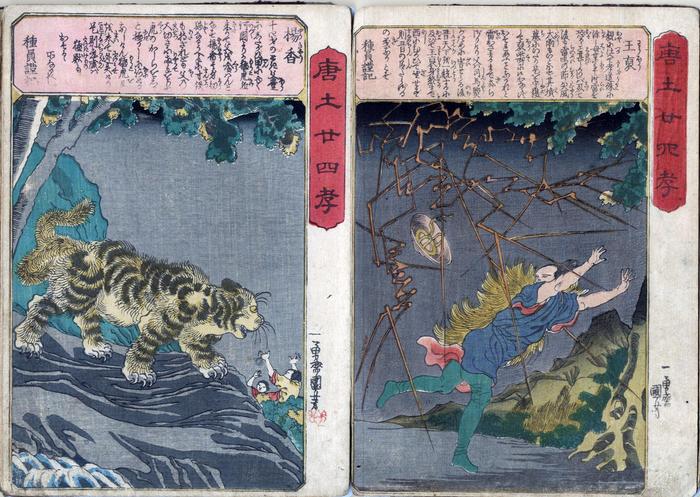Utagawa Kuniyoshi (歌川国芳) (artist 11/15/1797 – 03/05/1861)
Yōkyō (揚香) on the left and Ōhō (王裒) on the right, from the series The Twenty-four Chinese Paragons of Filial Piety (Morokoshi nijūshi-kō - 唐土廾四孝)
1848
13.5 in x 9.5 in (Overall dimensions) Signed: Ichiyūsai Kuniyoshi ga
一勇斎国芳画
Inscription: Ryūkatei Tanekazu
Kuniyoshi Project
Tokyo Metropolitan Library - left panel
Tokyo Metropolitan Library - right panel
Museum für angewandte Kunst, Vienna - right panel
Museum für angewandte Kunst, Vienna - left panel
Helsinki City Art Museum - right panel
Museum of Fine Arts, Boston - left panel
Östasiatiska Museet, Stockholm - right panel
Musées Royaux d'Art et d'Histoire (via Ritsumeikan University) - right panel only - trimmed
Musées Royaux d'Art et d'Histoire (via Ritsumeikan University) - left panel only - trimmed
Art Institute of Chicago - left panel only
Art Institute of Chicago - right panel only Below is R. Keller Kimbrough's translation of an early edition of the Nijūshikō. It does not specifically apply to these Kuniyoshi prints except in the most general terms.
[11] Yō Kyō 楊香 (Yang Xiang)
Meeting a white-browed tiger deep in the mountains,Yō Kyō had only a father. Once when Yō Kyō went into the mountains with him, they suddenly encountered a savage tiger. Fearing for her father’s life, Yō Kyō tried to chase it away. However, because she could not, she called on the mercy of Heaven. “I beg of you,” she earnestly prayed, “give my life to the tiger, and save my father!” Heaven must have been moved, because the tiger, which until then had been most ferocious in its appearance and had been on the verge of devouring her father, quickly furled its tail and ran away. Parent and child, together, had escaped the tiger’s maw, and without further ado they returned to their home. It is entirely because of the depth of Yō Kyō’s filial devotion that she could produce such a miracle.
she strikes with all her strength at its rancid breath.
Father and child together, without harm,
escape the clutch of its ravenous maw.
Kimbrough noted that: “Despite the translation, which uses female pronouns to refer to Yō Kyō, the Japanese text does not indicate Yō Kyō’s gender. However, according to the story in some other Japanese sources, she was a teenage girl.”
[14] Ō Hō 王裒 (Wang Pou)
His loving mother, afraid of thunder—Ō Hō was from a place called Ei’in. His father, Ō Gi 王義, had been executed by the emperor as a result of some unexpected affair, and because Ō Hō held a grudge about it, he refused for the rest of his life to sit facing in the direction of the emperor. He would stay at his father’s grave, kneeling and praying, and as he clung to an oak tree, he would weep and grieve. His tears fell on the tree, and people say that it withered. His mother had always been afraid of thunder, and so after she died, he would rush to her grave whenever there was thunder and lightning. “Ō Hō is here,” he would say as he circled her tomb, giving strength to his dead mother. Considering that Ō Hō was so filial after his parents had died, one can imagine how filial he must have been while they were alive. His were rare and wonderful deeds!
her pure spirit dwells in the pedestal of night.
At a single clap of the thunder god,
he visits her tomb and circles it a thousand times.
****
The text below was composed by Ryūkatei Tanekazu (柳下亭種員: 1807-58).
The text on the panel on the left reads: 十四才のとき父豊(ほう)にしたがひ田(でん)にゆく何國(いづく)よりか猛虎(もうこ)駈来(かけきた)りて父を喰(くら)はんとなす楊香(ようきやう)其身幼弱(ようじやく)なるうへ手に寸鉄(すんてつ)も持(もた)ざれども父(ちゝ)の大切(たいせつ)さに両手(りやうて)をもて虎(とら)のかしらをしかと撫(にぎ)りしに何(なに)とかなしけん猛虎(もうこ)尾(を)を巻(まい)て迯失(にげうせ)けり是則(これすなはち)孝感(かうかん)は猛獣(たけきもの)もおそるゝ所なるべし 種員謹[記]
The book entitled The Twenty-four Paragons of Filial Piety was written by the Chinese scholar Guo Jujing during the Yuan Dynasty. His pen name was Yizi, and he is known in Japan as Kaku Kyokei. The book recounts the self-sacrificing behavior of twenty-four sons and daughters who go to extreme lengths to honor their parents, stepparents, grandparents, and in-laws. Many of the images in this series appear Western in style, rather than Japanese, and were probably copied from Italian prints. The prints in this edition appear to have been printed two per ōban sheet (about 9.5 x 13.5 inches) and folded to chūban pages (about 9.5 x 6.75 inches). The were once bound together in an album.
Japanese name: Yōkyō
Chinese name: Yang Hsiang
Yōkyō at 14 years of age was accompanying his father into the mountains when a hungry tiger leapt out at them. Without thinking of his own life, Yōkyō protectively jumped in front of his father and thus scared off the tiger with his show of determined will.
Robinson: S60.11
Japanese name: Ōhō
Chinese name: Wang P’ou
Ōhō would rush to his mother’s grave during thunder storms to comfort her spirit, because she had feared lightning while alive. Robinson: S60.22
[The above English-language information is all taken directly from the Kuniyoshi Project.]
The text on the panel on the right reads: 王?(わうほう) 親(おや)に仕(つか)へて孝道(かうだう)殊(こと)に深(ふか)し母(はゝ)世(よ)に在(あり)し時雷(らい)を恐(おそ)るゝこと甚(はなはだ)しかりしば死(しゝ)て後も雷鳴(らいめい)の節(をり)は大風大雨(たいふうたいう)もいとはず其墳墓(はち)にいたり是を守護(しゅご)して?(ほう)此所(こゝ)に候かならずおそれ給ふことなかれと雷(らい)おさまるまで去(さ)らざりけり父は司馬☆(しばしやう)がために害(がい)せらる後(のち)晋(しん)天下(てんか)を一統(いつとう)するに及(およ)びて王?(わうほう)身(み)終(おはる)まで西(にし)にむかひて坐(ざ)せず則(すなはち)晋(しん)の臣(しん)たらざるの義(ぎ)なりとぞ 種員謹記
****
There is another copy of this print on the right in the Hachinohe Clinic Machikado Museum.
Historical - Social - Ephemera (genre)
Fushimiya Zenroku (伏見屋善六) (publisher)
Nijūshikō (二十四孝: The twenty-four filial exemplars) (genre)
